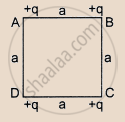Advertisements
Advertisements
प्रश्न
A particle with a charge of 2.0 × 10−4 C is placed directly below and at a separation of 10 cm from the bob of a simple pendulum at rest. The mass of the bob is 100 g. What charge should the bob be given so that the string becomes loose?
उत्तर
Given:
Mass of the bob, m = 100 g = 0.1 kg
So, tension in the string, T = mg
⇒ T = 0.1 × 9.8 = 0.98 N
For the tension to be zero, the repelling force (Fe) on the bob = T
Magnitude of the charge placed below the bob, q = 2.0 × 10−4 C
Separation between the charges, r = 0.1 m
When the electrostatic force between the bob and the particle is balanced by the tension in the string then the string will become loose.
Let the required charge on the bob be q' .
\[\Rightarrow F_e = \frac{1}{4\pi \epsilon_0}\frac{qq'}{r^2} = T\]
\[\Rightarrow \frac{9 \times {10}^9 \times q' \times 2 \times {10}^{- 4}}{{10}^{- 2}} = 0 . 98\]
\[ \Rightarrow q' = 5 . 4 \times {10}^{- 9} C\]
APPEARS IN
संबंधित प्रश्न
Two equal balls with equal positive charge 'q' coulombs are suspended by two insulating strings of equal length. What would be the effect on the force when a plastic sheet is inserted between the two?
Check that the ratio ke2/G memp is dimensionless. Look up a Table of Physical Constants and determine the value of this ratio. What does the ratio signify?
- Two insulated charged copper spheres A and B have their centers separated by a distance of 50 cm. What is the mutual force of electrostatic repulsion if the charge on each is 6.5 × 10−7 C? The radii of A and B are negligible compared to the distance of separation.
- What is the force of repulsion if each sphere is charged double the above amount, and the distance between them is halved?
Four charges +q, −q, +q and −q are to be arranged respectively at the four corners of a square ABCD of side 'a'.
(a) Find the work required to put together this arrangement.
(b) A charge q0 is brought to the centre of the square, the four charges being held fixed. How much extra work is needed to do this ?
Write any two important points of similarities and differences each between Coulomb's law for the electrostatic field and Biot-Savart's law of the magnetic field ?
Two insulating small spheres are rubbed against each other and placed 1 cm apart. If they attract each other with a force of 0.1 N, how many electrons were transferred from one sphere to the other during rubbing?
Find the speed of the electron in the ground state of a hydrogen atom. The description of ground state is given in the previous problem.
Two particles A and B, each carrying a charge Q, are held fixed with a separation dbetween them. A particle C of mass m and charge q is kept at the middle point of the line AB. Assuming x<<d, show that this force is proportional to x.
Repeat the previous problem if the particle C is displaced through a distance x along the line AB.
Answer the following question.
What is relative permittivity?
Write a short note on superposition principle.
Explain in detail Coulomb’s law and its various aspects.
Two-point charges of + 0.2 µµC and -0.2 µµC are separated by 1 o8 m. What is the value of the electric field at an axial point at a distance of 0.1 m from their mid-point?
The unit of charge is ______.
Four equal charges q are placed at the four comers A, B, C, D of a square of length a. The magnitude of the force on the charge at B will be ______.

Coulomb's law is given by F = k q1q2 rn where n is
The S.I unit of electric permittivity is
Two charges q and – 3q are placed fixed on x-axis separated by distance ‘d’. Where should a third charge 2q be placed such that it will not experience any force?
Four charges equal to −Q are placed at the four a corners of a square and charge q is at its centre. If the system is in equilibrium, the value of q is ______.
